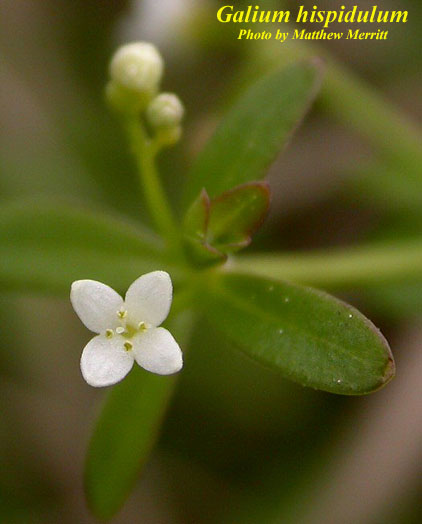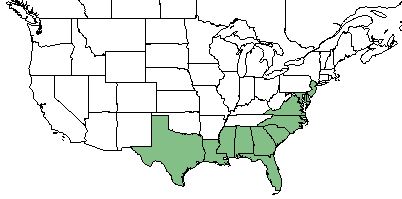Galium hispidulum
Common name: coastal bedstraw
| Galium hispidulum | |
|---|---|

| |
| Photo by the Atlas of Florida Plants Database | |
| Scientific classification | |
| Kingdom: | Plantae |
| Division: | Magnoliophyta - Flowering plants |
| Class: | Magnoliopsida - Dicots |
| Order: | Rubiales |
| Family: | Rubiaceae |
| Genus: | Galium |
| Species: | G. hispidulum |
| Binomial name | |
| Galium hispidulum Michx. | |

| |
| Natural range of Galium hispidulum from USDA NRCS Plants Database. | |
Contents
Taxonomic Notes
Synonyms: Galium bermudense L.
Varieties: none
Description
Also known as coastal bedstraw, G. hispidulum is a native perennial forb that is a member of the Rubiaceae family. [1]
Distribution
G. hispidulum is native to the southeast United States, ranging sparsely from east Louisiana and following the coastlines to Maryland and Delaware. [1]
Ecology
Habitat
G. hispidulum grows in maritime forests, dry sandy forests, and sandhills. [2] It is mostly found in well-drained soils along the Gulf coastal plain. [3] It is associated with the longleaf pine ecosystem.[4] While it is present in these natural communities, G. hispidulum is only seen occasionally and not as frequent. [5] It can be found in native cover communities as well as disturbed sites. [6] More specifically, habitats of G. hispidulum can range from loamy and drying sands in pine-wiregrass or oak-hickory woodlands, in general disturbed sites like open areas and crevices along roads, sand pine scrub, sand dunes and interdunal sandy flats, and various hammocks. [7] As well, it is considered an indicator species of the north Florida longleaf woodlands habitat.[8]
Associated species - Salvia lyrata, Elytraria caroliniensis, Dyschoriste humistrata, and Sanicula canadensis. [9]
Galium hispidulum is an indicator species for the North Florida Longleaf Woodlands community type as described in Carr et al. (2010).[10]
Phenology
G. hispidulum has been observed to flower from April until August, and in the months of October and December. [11] G. hispidulum has been seen to develop fruit during June through December. [7]
Seed dispersal
Seeds of G. hispidulum are primarily dispersed through animal consumption. [6]
Seed bank and germination
This species was not found to persist as a component of the seed bank even though it was present as herbaceous cover in southwest Georgia.[12]
Fire ecology
It commonly grows in habitats that are considered fire-dependent.[8] The species has been seen to be associated with a low rate of fire dependence, where the community is not burned as often as other normal sites. [13] As well, it can also be found in areas that are fire-excluded.[14]
Herbivory and toxicology
It consists of approximately 2-5% of the diet for various large mammals.[15]
Conservation, cultivation, and restoration
This plant is listed as endangered by the states of Maryland and New Jersey and their Department of Environmental Protection. [1]
Cultural use
This species can be used to make colored dyes, ranging in color from yellow to a rich red depending on which portion of the plant is used.[16]
Photo Gallery
References and notes
- ↑ 1.0 1.1 1.2 USDA Plants Database URL: https://plants.usda.gov/core/profile?symbol=GAHI
- ↑ Weakley, A. S. (2015). Flora of the Southern and Mid-Atlantic States. Chapel Hill, NC, University of North Carolina Herbarium.
- ↑ Allen, C. M. (2013). "Notes on the identification and distribution of the species of the genus Galium (Rubiaceae) in Louisiana." Journal of the Botanical Research Institute of Texas 7: 509-513.
- ↑ Brockway, D. G., et al. (2005). Restoration of longleaf pine ecosystems. F. S. United States Department of Agriculture, Southern Research Station.
- ↑ Rodgers, H. L. and L. Provencher (1999). "Analysis of Longleaf Pine Sandhill Vegetation in Northwest Florida." Castanea 64(2): 138-162.
- ↑ 6.0 6.1 Creech, M. N., et al. (2012). "Alteration and Recovery of Slash Pile Burn Sites in the Restoration of a Fire-Maintained Ecosystem." Restoration Ecology 20(4): 505-516.
- ↑ 7.0 7.1 Florida State University Robert K. Godfrey Herbarium database. URL: http://herbarium.bio.fsu.edu. Last accessed: June 2014. Collectors: Loran C. Anderson, John B. Nelson, R. K. Godfrey, C. Jackson, Sidney McDaniel, William R, Stimson, Tom Barnes, Angus Gholson, Wm. G. Atwater, S. Warren, John Morrill, A. F. Clewell, Gwynn W. Ramsey, S. Mitchell, Robert L. Lazor, A. H. Curtiss, Robert F. Thome, R. Kral, Siri von Reis, Gary R. Knight, R. A. Norris, Walter Kittredge, Kevin Oakes, J. M. Kane, John Schmiederer, and Cecil R. Slaughter. States and counties: Florida: Wakulla, Leon, Franklin, Volusia, Citrus, Jackson, Flagler, St Johns, Dade, Levy, Okaloosa, Walton, Dixie, Pinellas, Sarasota, Hernando, Bay, Suwannee, Gadsden, Washington, and Madison. Georgia: Baker, Thomas, and Camden.
- ↑ 8.0 8.1 Carr, S. C., et al. (2010). "A Vegetation Classification of Fire-Dependent Pinelands of Florida." Castanea 75(2): 153-189.
- ↑ Hill, N. M., et al. (2000). "Low catchment area lakes: New records for rare coastal plain shrubs and Utricularia species in Nova Scotia." Rhodora 102(912): 518-522.
- ↑ Carr, S.C., K.M. Robertson, and R.K. Peet. 2010. A vegetation classification of fire-dependent pinelands of Florida. Castanea 75:153-189.
- ↑ Nelson, G. PanFlora: Plant data for the eastern United States with emphasis on the Southeastern Coastal Plains, Florida, and the Florida Panhandle. www.gilnelson.com/PanFlora/ Accessed: 30 MAY 2018
- ↑ Andreu, M. G., et al. (2009). "Can managers bank on seed banks when restoring Pinus taeda L. plantations in Southwest Georgia?" Restoration Ecology 17: 586-596.
- ↑ Mehlman, D. W. (1992). "Effects of fire on plant community composition of North Florida second growth pineland." Bulletin of the Torrey Botanical Club 119(4): 376-383.
- ↑ Clewell, A. F. (2014). "Forest development 44 years after fire exclusion in formerly annually burned oldfield pine woodland, Florida." Castanea 79: 147-167.
- ↑ Miller, J.H., and K.V. Miller. 1999. Forest plants of the southeast and their wildlife uses. Southern Weed Science Society.
- ↑ Porcher, F. P. (1869). Resources of the southern fields and forests, medical, economical, and agricultural. Richmond, VA, Order of the Surgeon-General.